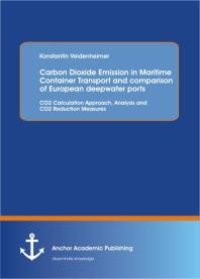
Ebook: Carbon Dioxide Emission in Maritime Container Transport and comparison of European deepwater ports: CO2 Calculation Approach, Analysis and CO2 Reduction Measures : CO2 Calculation Approach, Analysis and CO2 Reduction Measures
Author: Konstantin Veidenheimer
- Tags: Carbon dioxide mitigation -- Government policy -- Germany., Maritime law -- Germany., Carbon dioxide -- Environmental aspects., BUS000000, NON000000, NON000000
- Year: 2014
- Publisher: Diplomica Verlag
- City: Hamburg, GERMANY
- Edition: 1
- Language: English
- pdf
Maritime container transport accounts for approximately 90 percent of global trade volumes. Largest container vessels represent challenges for container ports, such as the required draft of 15.5 meters. In order to be competitive, many ports try to integrate in global supply chains. Furthermore, environmental issues play a growing role in the maritime business. Hence, this book concentrates on CO2 emissions from maritime supply chains involving European deepwater ports. This research investigates carbon dioxide emissions of maritime container transport from Asia into the European hinterland through new built German Jade-Weser-Port (JWP) compared to the deepwater ports of Rotterdam, Antwerp, Zeebrugge and Trieste. Furthermore, these ports are compared on the basis of competitive factors such as port characteristics and hinterland connectivity. This book also addresses measures for CO2 reduction in maritime door-to-door container transport. Auszug aus dem Text Text Sample: Chapter: 2.4.3 Port competitiveness: In order to address the second research question it is important to figure out characteristics that make a port competitive. Common competitive factors are geographical location, maritime access, port terminal performance, port charges, terminal capacity, dedicated berths, free trade zone, value added services, ability to handle different cargo types (e.g. general cargo/containers, roll-on/roll-off and bulk cargo) and inland connectivity (Ferrari et al., 2011; Pohnert, 2010; Leggate et al., 2005; Ng, 2009; Notteboom, 2009; Bichou and Gray, 2004). Song and Panayides (2008) argue that nowadays port supply chain integration is major competitive factor. If one transfers the supply chain competition concept from Christopher (2005) to the maritime industry one can state that competition no longer occurs between single ports but rather between maritime supply chains, within which ports are integral parts (Ferrari et al., 2011). Bichou and Gray (2009) differentiated between ‘organisational’ and ‘intermodalism’ port supply chain integration. The former means the linkage of nodes and different transport modes, whereas the latter is described as the prior cooperation between organizations in order to achieve intermodalism. Panayides and Song (2009), on the other hand, describe organizational integration as the ability of ports to provide value added services to companies. Notteboom (2008a; 2008b), argues that connection to advanced hinterland networks is a major prerequisite for successful supply chain integration, and that further development of hinterland links is indispensable in order to remain competitive. 2.4.4 Intermodal transport: ‘Intermodal transport’ or ‘multimodal transport’ is the movement of goods in a loading unit, such as ISO container or trailer, by at least two different transport modes (Branch, 2007; Rowbotham, 2008; Bauer et al., 2010; Winebrake et al. 2008). According to Venus Lun et al. (2009) in containerized movement intermodalism is an inherent part and enables worldwide door-to-door transport. Thus, in order to address the overall objective, following section will review the literature concerning estimation of carbon emissions from maritime door-to-door container transport. 2.5 Carbon auditing / Carbon footprinting: A carbon footprint is the amount of emitted green house gases from individuals, organisations, products, supply chains and activities. Carbon footprinting or carbon auditing is the CO2 estimation process (Carbon Trust, 2007; Piecyk, 2010; McKinnon, 2009). For carbon auditing of freight transport operations there are two basic approaches, namely, energy-based and activity-based method (Piecyk, 2010). According to Piecyk (2010) the former is quite simple to apply due to standardised energy or fuel conversion factors. However one need access to accurate fuel consumption figures (McKinnon, 2007). Activity-based method is based on transport activity data expressed typically in tonne kilometres (tkm). For calculation of activity data the weight of carried goods (in tonnes) and distance travelled (in kilometres) is needed. Distance data can be obtained by using online distance calculation tools. However, McKinnon and Piecyk (2010) argue that it might be difficult to get distance data from rail and barge or inland waterway transport. Furthermore, the authors argue that activity based approach might be more difficult to apply since there is a wide range of various emission factors that are based on numerous assumptions from different organizations. This study will use both activity and energy based methods. Following subsections will review the literature concerning various carbon auditing methods and tools for ocean freight, port handling, and hinterland transport by road, rail and inland waterway. Biographische Informationen Konstantin Veidenheimer, (MSc), was born in 1983 in Kazakhstan. He graduated his Master of Science study in Logistics and Supply Chain Management with distinction in 2011 in Edinburgh (UK). The Author received an award for Logistics Masters Dissertation of the Year 2012 by CILT UK (Chartered Institute of Logistics and Transport). Green Logistics and carbon auditing was one major research area during his study. Besides theoretical knowledge the author has also professional Know-How in maritime transport sector. This knowledge could successfully be transferred into this book.
Download the book Carbon Dioxide Emission in Maritime Container Transport and comparison of European deepwater ports: CO2 Calculation Approach, Analysis and CO2 Reduction Measures : CO2 Calculation Approach, Analysis and CO2 Reduction Measures for free or read online
Continue reading on any device:

Last viewed books
Related books
{related-news}
Comments (0)